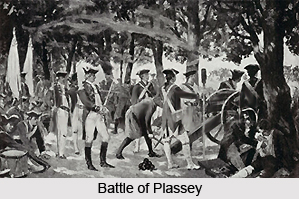 Decline of Nawabs in Bengal was due to lack of dynamism and ineffectiveness in handling the foreign rulers. The concerns of the Nawabs were limited to maintaining a decent Mughal order in which the subjects would be assured of a proper place. This was another constraint which the Nawabs of Bengal were bound to have known. Even Alivardi Khan had to accept many constraints however if he had planned skilfully perhaps he could survive. The survival of the Nawabs of Bengal would have assured that the provinces had a functional framework of government: a government that marked a commercial expansion and some growth in agricultural output. The regime lacked dynamism. The armies of the Marathas and Colonel Robert Clive did not give space to the Nawabs.
Decline of Nawabs in Bengal was due to lack of dynamism and ineffectiveness in handling the foreign rulers. The concerns of the Nawabs were limited to maintaining a decent Mughal order in which the subjects would be assured of a proper place. This was another constraint which the Nawabs of Bengal were bound to have known. Even Alivardi Khan had to accept many constraints however if he had planned skilfully perhaps he could survive. The survival of the Nawabs of Bengal would have assured that the provinces had a functional framework of government: a government that marked a commercial expansion and some growth in agricultural output. The regime lacked dynamism. The armies of the Marathas and Colonel Robert Clive did not give space to the Nawabs.
Alivardi Khan`s successful usurpation of Bengal encouraged others to establish their rule. The Marathas were the earliest and the dangerous competitors. By the year 1740 Marathas had conquered most of central India. They were pushing their influence further. The north-eastern arm of the Maratha enabled one of their leaders, Raghuji Bhonsla, to conquer Berar thereby being able to send troops from there. In 1742 Raghuji Bhonsla sent his army through Orissa and into western Bengal. The Maratha troops plundered the west of the Hooghly up to Murshidabad.
 The Nawab`s army repelled them. In l743 two Maratha the armies of Raghuji Bhonsla and Balaji Baji Rao had invaded respectively. Raghuji Bhonsla returned in 1744 and 1745, when his forces reached Murshidabad. The Nawab`s army managed to protect western Bengal, but was losing its grip on Orissa. In 1748 the Marathas appeared invaded Bihar. In 1750 they again raided Murshidabad. After 1751 there were no such campaigns. An agreement was reached between Alivardi Khan and the Marathas. Mir Habib sided with the Marathas and became the Naib of Orissa. The Afghans also started attacking Bihar though they were defeated.
The Nawab`s army repelled them. In l743 two Maratha the armies of Raghuji Bhonsla and Balaji Baji Rao had invaded respectively. Raghuji Bhonsla returned in 1744 and 1745, when his forces reached Murshidabad. The Nawab`s army managed to protect western Bengal, but was losing its grip on Orissa. In 1748 the Marathas appeared invaded Bihar. In 1750 they again raided Murshidabad. After 1751 there were no such campaigns. An agreement was reached between Alivardi Khan and the Marathas. Mir Habib sided with the Marathas and became the Naib of Orissa. The Afghans also started attacking Bihar though they were defeated.
By the 1750s Orissa had been lost. The fabric of agreement on which the Nawab s` government rested was stretched so long as Alivardi Khan remained alive. The Marathas tried to establish their rule in western Bengal attract the leading zamindars but they could not succeed.
Raghoji annexed Orissa and parts of Bengal and exploited the disorganized conditions that prevailed in the region post death of the Governor Murshid Quli Jafar Khan in 1727. The British East India Company began strengthening the defences at Fort William. Then the Nawab, Siraj -Ud -Daulah encouraged by the French attacked them. However under Robert Clive`s leadership, British troops and their local allies captured Chandernagore in March 1757. Nawab was defeated on June 23, 1757 at the Battle of Plassey as Mir Jafar`s soldiers betrayed him. He was assassinated in Murshidabad. The British established their own Nawab for Bengal. Chandernagore was restored to the French. There was an attempt by the Bengal rulers in alliance with Mughal Emperor Shah Alam II to regain their territories in 1765 but were defeated again at the Battle of Buxar (1765).



















